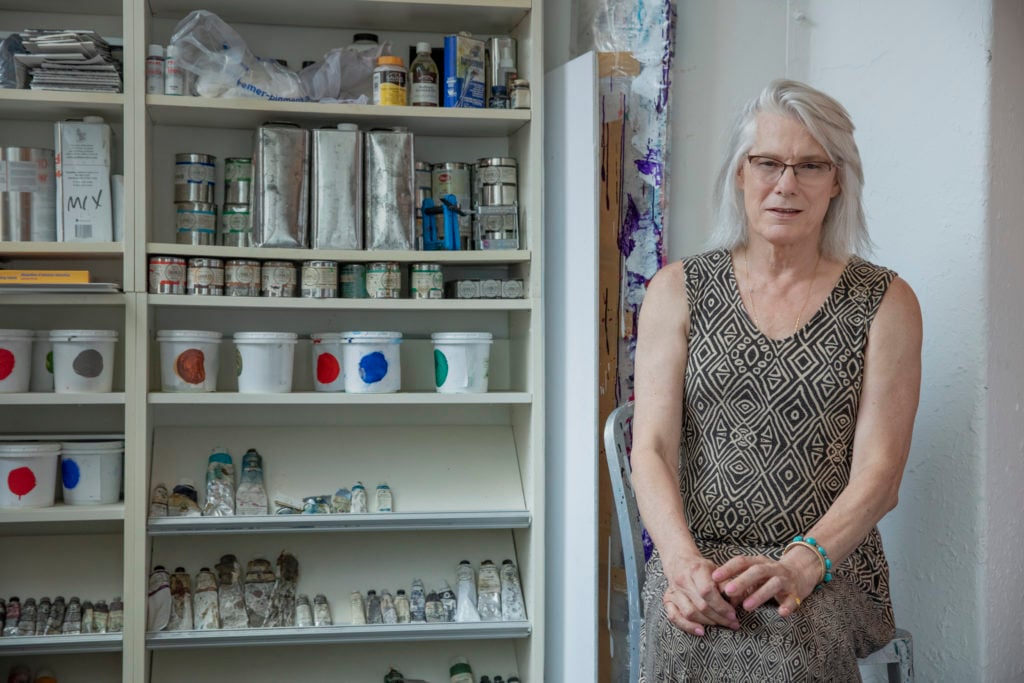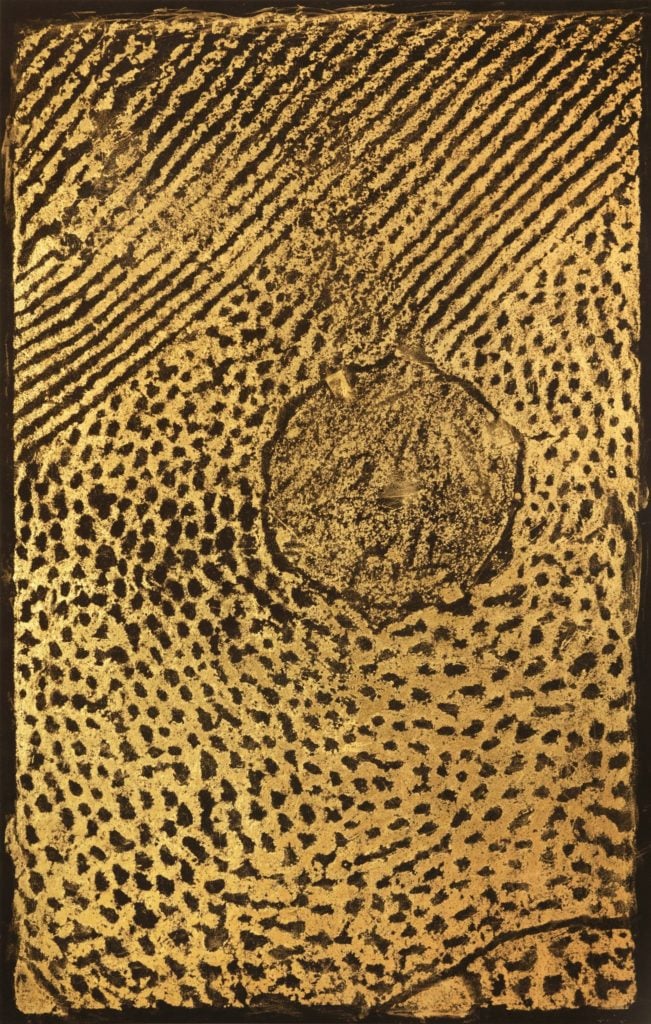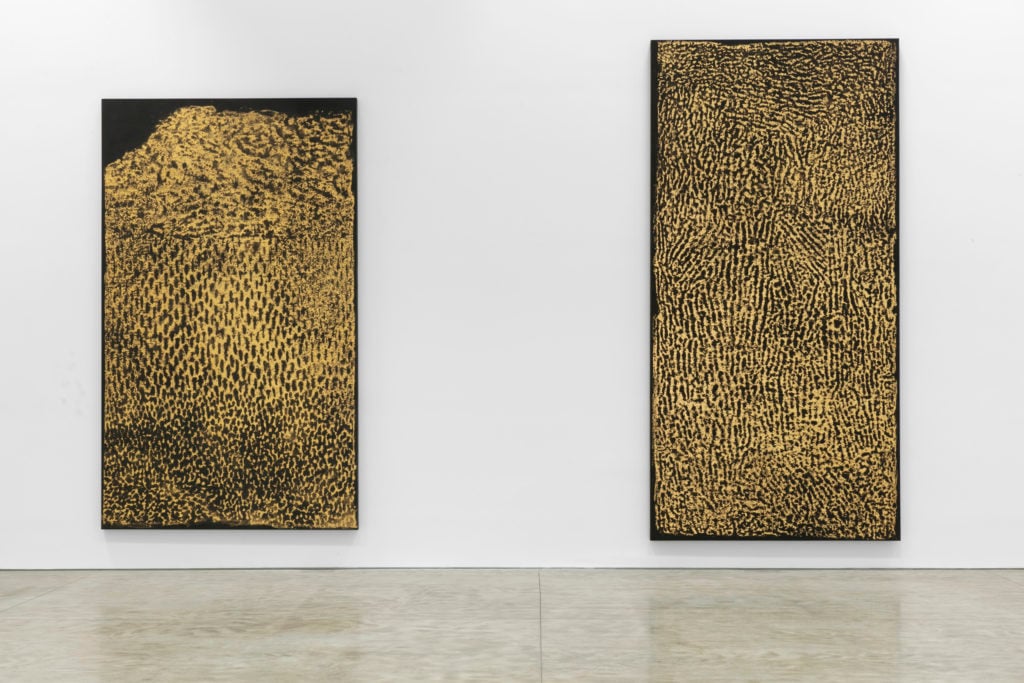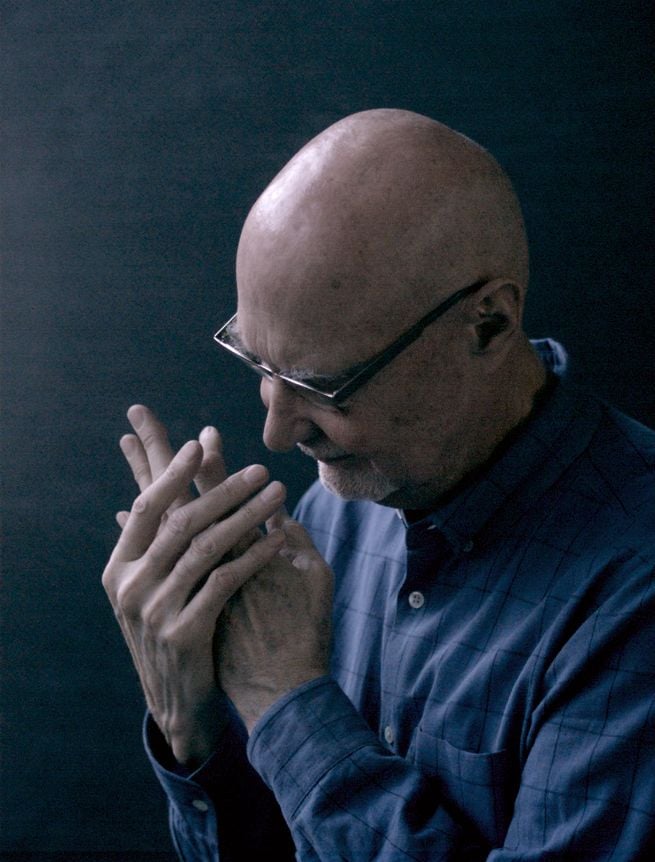People
James Nares, an Artist Known for Mapping New York’s Changing Landscape, Is Now Navigating a Deeply Personal Transition of His Own
The artist is currently the subject of a retrospective at the Milwaukee Art Museum.

The artist is currently the subject of a retrospective at the Milwaukee Art Museum.

Max Lakin

The late, great writer Glenn O’Brien once said that James Nares might sound a bit British, but he’s a New Yorker at heart. Nares does speak with a latent, languid London accent, but there are few artists whose work has embodied the thrum of New York like his.
You can make the argument, as Nares has, that the defining characteristic of the city is its streets. Much of the artist’s work has located itself there, specifically the street surface, the textural layer of the concrete and asphalt and all the visual information caked into it. Since his arrival to New York in 1974, the street has been Nares’s great protagonist and, in the intervening years, he has spent a lot of time looking down.
“The surface of the city, it’s just something that never goes away,” Nares said. “It’s a history of sorts. And it’s a less protected history, less cared for. I guess that appeals to me in a way. It’s pretty democratic. It’s walked on. It’s used. It wears its history on its face, endless layers upon layers of road paint.”
The subject matter of Nares’s newest body of work, the granite paving stones that make up lower Manhattan’s sidewalks, would be familiar to anyone who’s ambled through Soho or gawked from the curb as another glassine condo rises over Tribeca. Yet in “Monuments,” Nares’s recent show at Kasmin gallery in New York, the sidewalk is made new, even alien. Over the last year, he has made wax frottage rubbings of the oldest examples, some upwards of 200 years old, pressing the impressions with 22-carat gold leaf. Laid by immigrant artisans and mottled with traction-giving grooves and gouges, the paving stones can resemble brutal abstractions or primitive runes. Gilded and hoisted onto the wall, they’re strange and sweet monoliths, tributes to the anonymous workers whose hands still shape the contours of the city. It’s a touching tribute to the city and its capacity to fold time.

James Nares, Prince II (2018). Courtesy of the artist and Kasmin.
In a way, “Monuments” is a corrective, an acknowledgement of the people who contributed to the city’s texture in a tangible way, and, as a byproduct of the sour political tenor of the moment, a rather pointed statement about the immigrant labor from which this country benefits. Like gravestone rubbings, they’re a devotional act. “We could do two big ones in a day,” Nares said of the process. “It’s amazing how tiring it was, scrubbing the sidewalk. I joked that we were paying homage to our ancestors, the guys who made the marks in the first place, just a group of us bullshitting around, talking about this and that, which is just how I imagine them doing it,” he said. “I imagine them as masons from different countries who were mixing and making these things together. It’s my imagination which is the most important thing at that point. I’m close enough, I think, to the truth, whatever it is. Intimate touches, that’s all we have.”
For an artist so consumed with gesture and mark making, “Monuments” is different. The works are chiefly the marks made by someone else, anointed. They’re less about process than about seeing. They’re a gift, really, one that allows us to see ourselves. “I’m not a great sentimentalist,” Nares said. “I’m a realist when it comes to New York. I was reading Edith Wharton’s letters, and she was saying, ‘Goddamnit, I don’t recognize the neighborhood I grew up in.’ But I like to acknowledge those things, and it does make me sad when those things are obliterated. We do do it very callously. I think possibly having a European background enables me to attach myself to the importance of things made a long time ago—an awareness of history that isn’t as endemic to this country. But it’s a conundrum, because that’s also what makes things so great here, the ability to make it new, and have another one, the next model.”
To a large degree, the works are also monuments to Nares’s time in New York. It’s perhaps fitting that this happens to be a time of personal transition for Nares. “Monuments” accompanies a retrospective, the artist’s first, at the Milwaukee Art Museum, titled “Moves,” on view now through October 6. And he’s preparing to move from his studio of 10 years in West Chelsea, where the rent is set to double (a parallel New York narrative), to a new space in Long Island City, Queens.
Much more than that, Nares is embracing a side of himself personally that he has to this point in his life repressed. In May, at a lunch at Kasmin, Nares publicly presented as a woman for the first time, and with artist friends like Walter Robinson and Julian Schnabel looking on, spoke rawly about the pain he had been suppressing for so long. (Nares still uses male pronouns and his given name professionally.)
“It’s coincidental that these things have all sort of come to a head at the same time,” Nares said at his studio a few weeks later. “It’s been a large and basically unacknowledged part of me for as long as I can remember, and I think it’s in many ways the cause of much suffering in my life, addictions and all that stuff. I mean, I’m an addict because I’m an addict, I don’t believe any circumstance made me an addict, but if there were things that I could tie to the kind of suffering that I was trying to mitigate with my substance abuse, this would certainly top the list. But I’ve neglected it for all my life, though that’s not quite true, when I was living in London, my very first show in a gallery was pictures of myself presenting the way I do now. It was just something I did and never did publicly again.”
Curated by Marcelle Polodnik, the Milwaukee Museum retrospective cycles through the movements of Nares’s career, beginning with the early, no-budget Super 8 films he made in the mid-1970s, like Block, a stuttering shot of a hand tracing the length of a Manhattan city block (incidentally, the southern wall of the Church Street post office, the only structure on the northern perimeter of the World Trade Center to remain in tact after September 11), and Pendulum, in which Nares swings a water-filled copper sphere—an ersatz wrecking ball—through a pre-gentrified Tribeca and films it slicing through the air; to his road paint canvases, which he made using a modified pavement line-striping machine; into his calligraphic, single brushstroke paintings, sinuous whorls of cadmium and cobalt and vermillion, which, because of the physicality involved—he made some made by suspending himself in a rig above the canvas—are as much body art as anything. “Those paintings have a kind of sensual quality, which my work hadn’t expressed before in quite the same way,” Nares said. “There’s a strong representation of my feminine aspect. They’re very sensual.”

Installation view of “James Nares: Monuments.” Photo by Diego Flores, courtesy of Kasmin.
At just 66 years old, Nares hadn’t really been in a retrospective frame of mind, even as Polednik had periodically broached the idea over the past six years, but installing the Milwaukee show proved to be a cathartic experience. “It was exciting to see some old friends,” he said of his early works. “The threads are all up here, you know. But I realize that the threads have never been made clear before. Even my kids were saying, ‘Wow, papa, you made this?’ People hadn’t seen the work and hadn’t had the connective tissue put in front of them, the thread unraveled.”
The Milwaukee show presents an uncanny sense of overlap, the past and present looping into one another. Street, Nares’s 2012 film, in which he trawled Manhattan in a car fixed with a Phantom Flex high-speed camera and slowed the gathered footage to an immaculate, yearning 61 minutes, has echoes of the Super 8 films that made New York’s street level strange, but also the work to come, like Portraits, tightly cropped short films of individual sitters shot similarly, so that every muscle ripple reverberates like an earthquake.
Seeing Street and Pendulum in the same space illuminates their shared feeling, an illusion of controlled chaos that gives way to an ecstatic reverie. Pendulum inhabits the obliteration of the city in the ’70s, it’s kinetic destruction, but also its capacity to incubate art, and, by extension, a future. So too does Street trace a particular moment of the life cycle of the city. As ebullient as it is, there’s the understanding that this version of New York is not long for the world, and that the people sliding through it won’t necessarily be here to see the next. In it, and in all of it, there is a birth and death.
After raising a family, and a number of marriages, Nares has gradually grown more comfortable presenting publicly as a woman. “I’ve been more open about it. There are all these corny expressions—‘live my truth’—I don’t think what I was living before was untrue, but I’ve reached a point in my life—I have three beautiful daughters and a lovely stepson who I adore, and I’m 66 today — it’s time to just give myself a break. I had told my kids, and they were all immediately supportive, which was amazing. And [my daughter] Zarina asked me if she could see some photos of myself, and she said, ‘Oh, these are great, can I post one on Instagram,’ and I said, ‘yeah, sure,’ forgetting for a crucial moment the power of social media. The next thing I knew I was getting phone calls from everybody. I sort of went from 0 to 100 overnight, and so the cat was out of the bag, and it was like, well, you know, maybe that’s better.”

James Nares, Douglas, still (2015). Photo courtesy of the artist and Kasmin.
The changes in Nares’s life are an evolving process. “There was always this terrible fear, until very recently,” he said. “Something shifted, and it shifted quite quickly. I’ve tried dodging it and I’ve tried mostly hiding it, and now there’s a great feeling of congruence between the way I am and the way I show myself. I’m also, I’m realizing, part of what allowed it to happen. My generation of artists sowed many seeds that have come to fruit with these younger generations. If I think back to, like, Mapplethorpe, Jack Smith, I was part of the work that was done, even if I wasn’t addressing it directly, I was there, I was supportive, and in a way I’m reaping that.”
Because Nares’s work touches a handful of art historical movements, from Minimalism to No Wave, with a few stops in between, categorization is, fittingly, perhaps not the most useful effort. “I was aware of those things, those divisions and subgroups,” Nares said. “And I understand why those divisions appear, because that’s sort of the natural way people reduce or define or pare things down to a readily understandable tag so you can reference it in conversation or whatever, and I understand also how people get pissed off, you know, ‘I’m not a pop artist!’ or whatever it is. At this point, I don’t know what I am. The categories did kind of break down in the last I-don’t-know-how-many years, there has been a rupture, which appeals to me, because I’m just that way myself. I have too many interests. It all just percolates in my mind and every now and then something floats to the top, and that’s what I do.”
“Nares: Moves” is on view at the Milwaukee Art Museum through October 6, 2019.